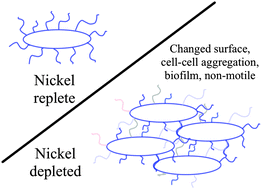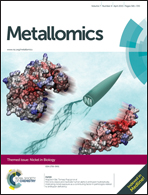A new insight into the role of intracellular nickel levels for the stress response, surface properties and twitching motility by Haemophilus influenzae†
Abstract
Nickel acts as a co-factor for a small number of enzymes in bacteria. Urease is one of the two nickel-dependent enzymes that have been identified in Haemophilus influenzae; glyoxalase I is the other. However, nickel has been suggested to have roles in H. influenzae that can not attributed to the function of these enzymes. We have previously shown that in the H. influenzae strain Rd KW20 the inability to acquire nickel led to alterations to the cell-type; an increased biofilm formation and changes in cell surface properties. Here we report the differences in the genome wide gene expression between Rd KW20 and a strain incapable of importing nickel (nikQ); revealing a link between intracellular nickel levels and genes involved in metabolic pathways, stress responses and genes associated with surface factors such as type IV pili. We have then taken a strain previously shown to use type IV pili both in biofilm formation and for twitching motility (86-028NP) and have shown its homologous genes (NTHI1417-1422; annotated as cobalt transporter, cbiKLMOQ) did import nickel and mutations in this locus had pleiotropic effects correlating to stress response and motility. Compared to wild type cells, the nickel depleted cells were more electronegativity charged, they aggregated and formed a biofilm. Correct intracellular nickel levels were also important for resistance to oxidative stress; the nickel depleted cells were more sensitive to oxidative stress. The nickel depleted cells were also non-motile, but the addition specifically of nickel returned these cells to a wild type motility state. We have also analysed the role of nickel uptake in a naturally, urease negative strain (the blood isolate R2866) and depleting intracellular nickel (a nikQ mutant) in this strain effected a similar range of cell functions. These data reveal a role for the capacity to acquire nickel from the environment and for the correct intracellular nickel levels as part of H. influenzae stress response and in signalling for a switch to a sessile bacterial lifestyle.

- This article is part of the themed collection: Nickel in biology

 Please wait while we load your content...
Please wait while we load your content...